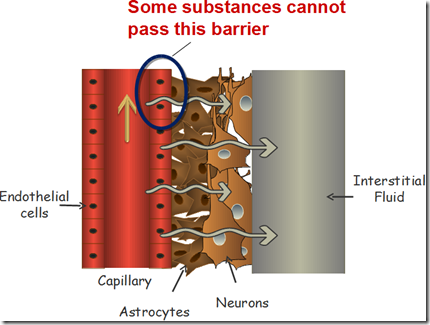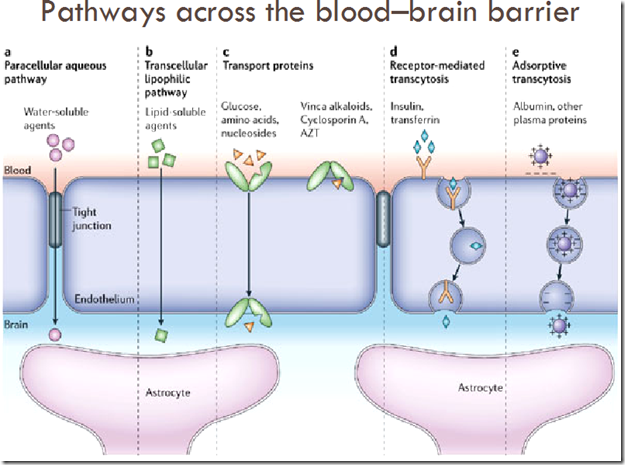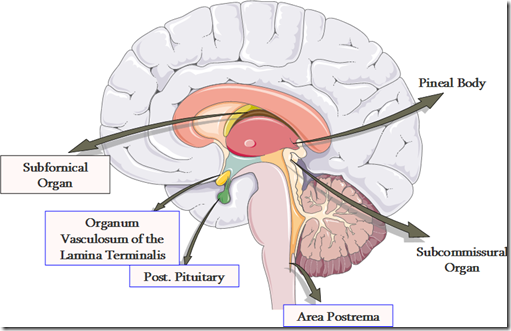Blood brain barrier:
Tight junctions in the endothelium of brain vessels & thick basal lamina surrounding the external face of the capillary & feet of astrocytes.
- separation of circulating blood and cerebrospinal fluid(CSF) in the central nervous system (CNS)
- Function:
- physical barrier
- system of cellular transport mechanisms
- maintains homeostasis
- restrict entrances of harmful chemicals from the blood, and allowing entrance of essential nutrients
- Why is it important?
- The brain (neurones) is very vulnerable to changes in it’s environment
- therefore only substances necessary for normal function are allowed to pass through
- It occurs along all capillaries and consists of tight junctions around the capillaries that do not exist in normal circulation
- Not well developed in infants
- bilirubin can cross the barrier to reach the basal ganglia in the haemolytic disease of the newborn – causing fits
- kernicterus
Types of blood-brain barrier
1) Blood-ECF barrier
- in the CNS capillary bed
2) Blood-CSF barrier
- in the choroid plexus
- lateral 3rd & 4th ventricles
- Made up of capillaries covered by
- Pia mater
- Ependyma (tela choroidea)
- Ependymal cells are modified:
- cilia are replaced by microvilli
- they have numerous enzymes specifically involved in the active transport of ions & metabolites
- there is a basement membrane beneath the epithelium
- Tight junctions are present between the ependymal cells
- at the apices
- Ependymal cells are modified:
- Freely permeable to water
- Permeable to
- non-ionised lipid soluble substances
- ethanol
- caffeine
- Not permeable to
- protein
- protein-bound substances (Drugs,hormones)
- strongly hydrophilic (water soluble) substances (Na,K)
- use of specialised carrier-mediated transport mechanisms
Apart from the choroid plexuses, CSF can come into contact with ECF of brain tissue at:
- Ependymal cell-ECF interface
- Subarachnoid space-ECF interface
Endothelial cells
- The brain endothelial cells are joined by tight junctions of high electrical resistance
- providing an effective barrier against molecules
- in peripheral endothelial, there is good transcellular movement of molecules. However, there is no such movement in brain endothelial cells
- providing an effective barrier against molecules
- The brain capillaries are in contact with foot processes of astrocytes
- which essentially separate the capillaries from the neurons
Transport systems
Blocks
- metabolic wastes
- urea
- creatinine
- proteins
- toxins
- most drugs
Highly permeable to
- water
- glucose
- essential amino acids
- strictly no entry for non-essential amino acids
- some electrolytes
- strictly no entry for K+
- lipid-soluble substances
- fats
- fatty acids
- oxygen
- CO2
- alcohol
- nicotine
- anaesthetics
Areas outside the blood-brain barrier (areas exposed to blood)
- those involved in regulation of blood chemistry & osmolality
- Circumventricular areas
- 3rd & 4th ventricles
- vomiting centre of the brain stem
- hypothalamus
- exposed to plama osmolality (thirst centre)
- -ve feedback by hormones
- Circumventricular organs(takes up injected dye)
- posterior pituitary (AVP, OT)
- neurohemal organs
- area postrema (ANG II)
- increase BP, vomiting centre
- organum vasculosum of the lamina terminalis (OVLT) (ANG II)
- thirst & ADH secretion
- in infection, IL-1 acts on OVLT to produce fever
- Subfornical organ
Drugs & blood-brain barrier
Antibiotics
- Penicillin
- only small amounts of systematically administered penicillin can cross
- drugs that cannot cross BBB needs to be administered intrathecally (through CSF)
- but the meninges become more permeable locally in meningitis
- Readily cross BBB
- Chloramphenicol
- Tetracyclines
- Sulphonamides
- Erythromycin
- Sulphadiazine
Barbiturates (eg. thiopentone)
- they are lipid-soluble
- can cross BBB
Neurotransmitters (eg noradrenaline)
- water soluble (hydrophilic)
- can’t cross BBB
Antihistamines
- Older antihistamines
- can cross BBB
- side effect: sedation
- Newer antihistamines
- far less likely to cause sedation
- sometimes occur
Morphines
- 2 hydroxyl group
- cant cross BBB (water soluble)
Heroin
- 2 acetyl groups (COCH3)
- more lipid soluble
- crosses BBB readily
- enzymes in brain convert heroin to morphine which gets trapped in the brain and may have prolonged effects
Other drugs that are highly lipid soluble
- nicotine
- caffeine
- alcohol
Clinical relations to BBB
- In Cerebrovascular accidents (stroke)
- trauma can lead to accumulation of interstitial fluid in the brain (oedema)
- not permeable to BBB
- excess fluid in brain tissue can be removed by imposing an osmotic gradient across the BBB
- Mannitol is used for this purpose
- it does not cross BBB and acts as an effective osmole
- intravenous infusion of mannitol results in the movement of fluid from brain tissues by osmosis
- Against microbial invasions
- most bacteria cannot cross BBB (rare)
- but can enter the brain from other routes
- sinus
- dental procedures
- since antibodies are big molecules & can’t easily cross the BBB
- bacterial infections are often serious & difficult to treat
- some viruses and fungi can
- treponema pallidum burrows through the vessels
- Breakdown of BBB
- injury
- leakage of fluid
- brain tumour
- capillaries are fenestrated
- infection
- WBC can cross
- hypertension
- raised pressure widens the tight junctions









